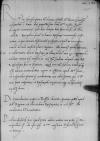Cum diu exspectassem litteras Dominationis Vestrae Reverendissimae de negotio Varmiensi, sub idem tempus ⌊⌋ sunt mihi ab illa redditae, ex quibus simul et domini ⌊episcopi Varmiensis⌋ institutum, in quo animum offirmavit, perspexi et quid in ea re faciendum Dominatio Vestra censeat, plane cognovi. Ac tametsi quidem animum et voluntatem domini ⌊episcopi⌋ ex illius ad me [litte]ris iam on the margin⌈litte hidden by binding⌈[litte]litte hidden by binding⌉ris iam[litte]ris iam on the margin⌉ ante ego cognoveram, nolebam tamen nisi consilio Dominationis Vestrae Reverendissimae habito aliquid cum ⌊maiestate regia⌋ super hac re statuere. Quod cum nunc habeam intelligamque esse ad rem accommodatum, agam et efficiam apud ⌊maiestatem suam⌋, ut responderi faciat se coadiutorias non admissuram, quae et novae sunt captiones et episcopali dignitati atque auctoritati nequaquam decorae.
De contributione nuper in ⌊Prussia⌋ decreta faciam operam apud ⌊maiestatem regiam⌋, ut illa in bonis ⌊episcopatus⌋ Dominationis Vestrae Reverendissimae illi condonetur et remittatur.
⌊Paulum Fasolth⌋ iuvi, quod potui, aliter autem non potui, quam ita, ut factum est, de quo ipse Dominationem Vestram Reverendissimam faciet certiorem.
 BCz, 1595, p. 446
BCz, 1595, p. 446
In aula nihil aliud est actum scitu dignum, nisi quod ⌊maiestas regia⌋ pro sui animi lenitate et sincero in rem publicam Christianam affectu, cupiens pacem et concordiam toties frustra temptatam inter ⌊reges dissidentes⌋ denuo sollicitare et suadere, miserit nuper magnis itineribus dominum ⌊Nicolaum Nipschicz⌋ ad serenissimum ⌊regem Ferdinandum⌋ explorandi causa, an ms. c(!)
⌈nn ms. c(!)
⌉ ad ineundam hidden by binding⌈[m]m hidden by binding⌉ cum ⌊adversario⌋ concordiam consentire vellet et agendi, ut si non abnuat concordiam, oratores huc in ⌊regnum⌋ ⌊maiestatis suae⌋ ad illius tractationem mittere non recusaret.
In his rebus, quid ⌊maiestas sua⌋ proficiet, cum ego cognovero, Dominationem quoque Vestram Reverendissimam facere certiorem curabo. Cuius amori et benevolentiae fraternae me commendo et felicem atque recte sanam esse semper opto.



 BCz, 1595, p. 448
BCz, 1595, p. 448